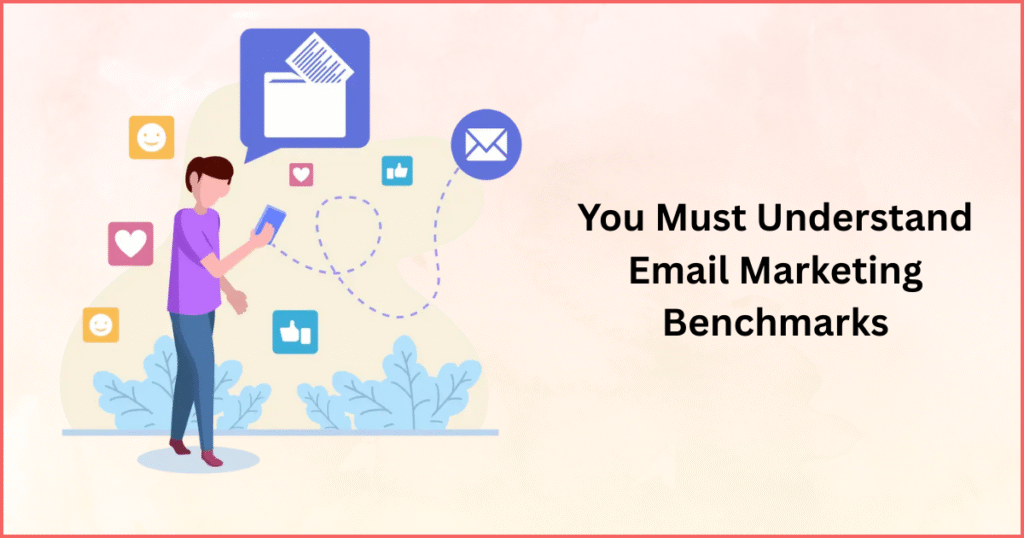By understanding how their email marketing campaigns stack up against benchmarks, marketers can realize the immense potential of email marketing.
Data can be confusing; however benchmarks help guide marketers in making strategic decisions based on data analytics. For seasoned marketers honing their strategies or for novices hoping to make a name for them, these benchmarks keep one on top of their game and lead to actual achievements.
In this blog we are going to focus on the key Email Marketing benchmarks that every marketer should know. These measures range from open rates and click through rate to conversion rate which provides helpful insight into your email’s performance.
How Important Are Benchmarks for Determining The Effectiveness Of Email Marketing?
Benchmarks are essential when it comes to evaluating the effectiveness of an email marketing strategy for they allow marketers to measure their campaigns against specific parameters. Below is a discussion of their importance:
Performance Evaluation
Marketers can compare their email campaigns to standards set by the industry, using benchmarks. These include rates are opening messages, click-through rates (CTR), converting readers into buyers throughout the whole process, and getting unsubscribed lists bounced back to oneself. By doing this, they can find out if what they are doing works or requires some modifications.
Goal Setting
Organizations can establish achievable and knowledgeable goals through referencing points. Organizations can provide targets that are optimistic but also plausible by knowing what a decent open rate or click-through rate is in their field, which helps to promote persistent enhancement of their initiatives.
Optimizing Strategies
marketers can spot lower performing areas in their campaign by comparing them with benchmarks. With this knowledge, they will be able to take a decision based on facts hence allowing them to adjust their plans. This may range from modifying an email subject line, altering a CTA, or changing when an email is sent.
Competitive assessment
The benchmarks enable organizations to assess their achievement against those of their competitors. This knowledge about competitors’ performance can serve as a catalyst for companies to bring forth creativity and keep pace with these changes.
Trend Identification
For instance, industry standards can provide insights into tentative email marketing changes such as rising mobile device use or enhanced effectiveness of personalization tactics. If marketers remain abreast of these trends, they will be able to modify their strategies so they remain pertinent and efficient.
Allocation of Resources
Businesses can allocate their resources effectively by knowing which components of an email marketing campaign generate the greatest yields. Benchmarks can show marketers how to invest more successful strategies while reducing investments in processes having less success.
Is email marketing really on the rise? We should analyse some standards
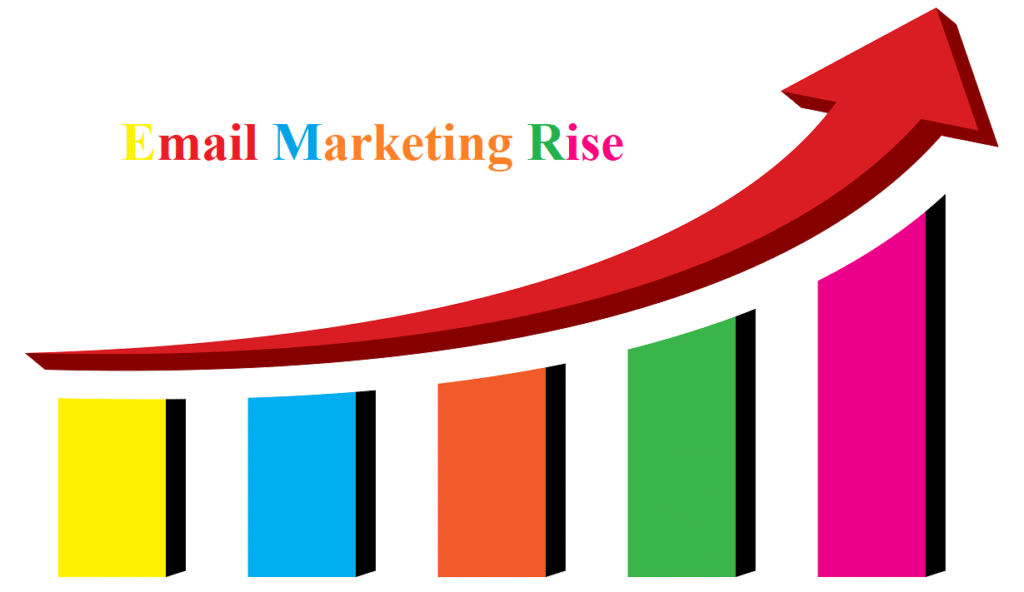
The landscape of email marketing has witnessed enormous expansion and change recently, accentuated by a number of interesting statistics that show how it is growing and working better. In the midst of the COVID-19 crisis, global mail market estimated at $ 7.5 billion with prediction for 2027 to hit almost 18 billion US dollars. The trend indicates an increasing dependency on email marketing and more benefits arising from it across all sectors.
The rise in global email communication was recorded at 14% between 2020 and 2021; this is a figure that has its roots in the pandemic but now continues to be normal. It still confirms adaptability as well as the resilience of email marketing techniques against changing consumer moods and international challenges.
E-mail marketing is one of the strategies that comprise the majority of digital marketing as 82% of marketers use it in their entire marketing programs. This indicates how popular email marketing is because even data gathering and analysis like that carried out by Sales force is in support of this theory; for instance, it conducted a double-blind study among 6,950 full-time heads of the world’s marketing field. The methodology was so thorough that it made sure about the reliability and thus, affirms why email should be part in today’s advertising methods.
Moreover, Mobile platforms are now the major way of connecting to email for the masses, thus changing the manner in which users respond to the contents anytime they lay their eyes on them. At present, 42 % of emails are read from mobiles while within youth population; this proportion grows to 67 % or more among those who belong Generation Z or 59 % belonging to Millennial. It has become very crucial that the content meant for email marketing be modified for mobile devices because people use different types of screens at different ages.
Consumer preferences further reveal the central role of email in brand communication strategies. More than half (51%) of consumers prefer to be contacted by brands through email, exceeding any other communication channel. This preference, along with the decrease of average time spent reading an email from 13.4 seconds in 2018 to 10 seconds today, poses a challenge for marketers to create concise & engaging contents that can grab customers’ attention quickly.
When it comes to email marketing, the most widely used email provider in the world is Gmail, with an active user base that has reached more than 1.5 billion as of 2019. Gmail has 31.6% of emails being opened, which puts it in second position after Apple’s 55 .6%. In email client market share, Gmail sits second after apple’s 55.6%. Hence, understanding how various email clients operate is critical for optimizing your marketing strategy through emails so as to get a broader audience.
Email Open Rate Benchmarks
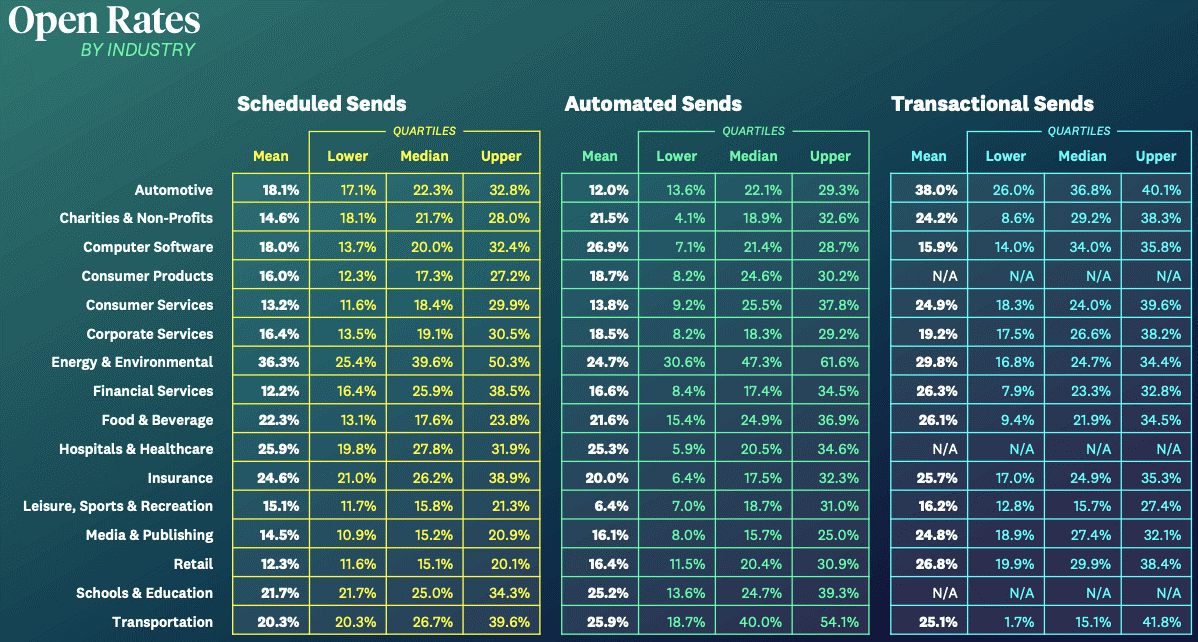
Source: (https://www.smartinsights.com/email-marketing/email-communications-strategy/statistics-sources-for-email-marketing)
Email open rates certainly vary greatly across industries, showing how varied audiences interact with email content. Nevertheless, one thing they have in common is the outstanding performance of welcome emails. When it comes to open rates, welcome emails always win over other kinds of email messages.
In line with Flodesk reports, welcoming emails have a mind-boggling 86% open rate.
Several aspects contribute to this occurrence:
– First Impressions Count: The first time someone subscribes to your email list is when they are most interested in your brand. Therefore, sending a welcome email at such a time will take advantage of their interest and bring about high rates of opening it.
-Expectation: Upon signing up, subscribers are often expectant of a welcome email hence increasing the chances of opening it when delivered to their inbox.
-Personal Touch: Welcome mails are usually personalized for the purpose of introducing subscribers to the brand, right from the start making them feel appreciated and part of the community.
Transactional emails have lesser rates, standing at an average of 40-50%.
Abandoned cart email open rates hover around 45%.
Click-Through Rate Benchmarks
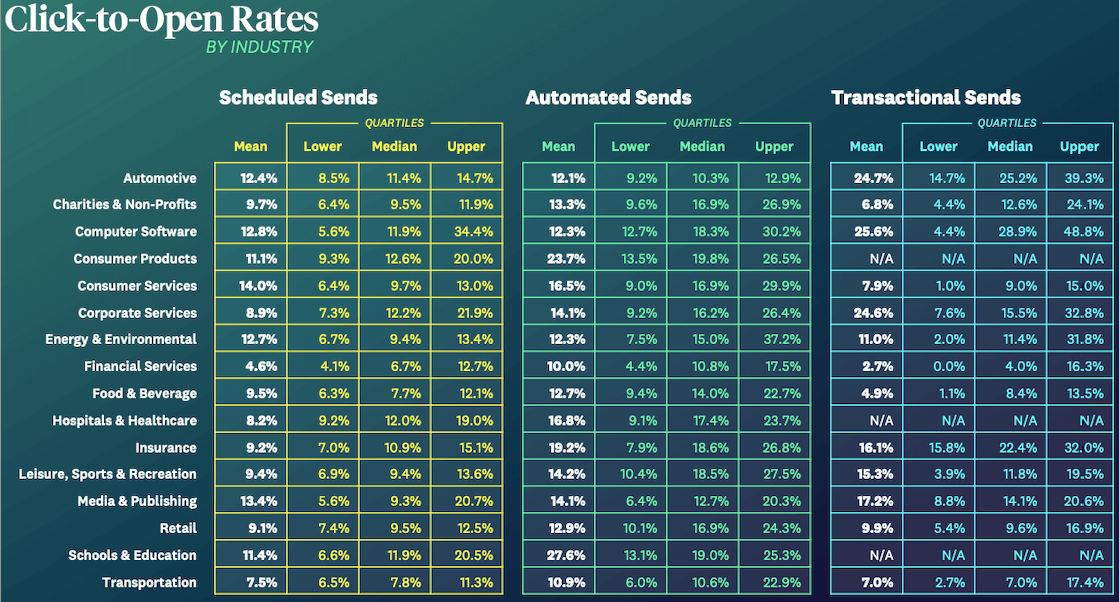
Source: (https://www.smartinsights.com/email-marketing/email-communications-strategy/statistics-sources-for-email-marketing)
This email benchmarks compilation from Acoustic (previously IBM Marketing and Commerce) includes data from 750 companies which are representative of 3000 brands within different industries across 40 nations. It provides a good comparison between your email marketing initiatives with other similar organizations in that particular field.
Key points to note:
– Computer Software Industry. The computer software industry has a notably high upper quartile for click-to-open rates when it comes to scheduled messages at 34.4%. This indicates that the most successful emails in this sector have much higher engagement rates than other industries.
– Financial Services. For scheduled messages, this industry has a comparatively low mean click-to-open rate of 4.6%. This suggests that it is more difficult to engage their recipients compared to other sectors.
– Retail: In the scenario of automated transmissions, retail sector is performing very well as evidenced by its average click-to-open rate being 12.9% thus indicating substantial degree of involvement with automated electronic mail marketing efforts.
– Media & Publishing: On the other hand, for automated transmissions, median Click to Open Rate (CTOR) in this industry stands at a remarkable 14.1%. Therefore, implying that such distribution modes are significantly beneficial within media and publishing sector.
– Transportation: Moreover transactional sends in this sector have recorded an average click-to-open rate (CTOR) of only 7%.
Unsubscribe Rate Benchmark
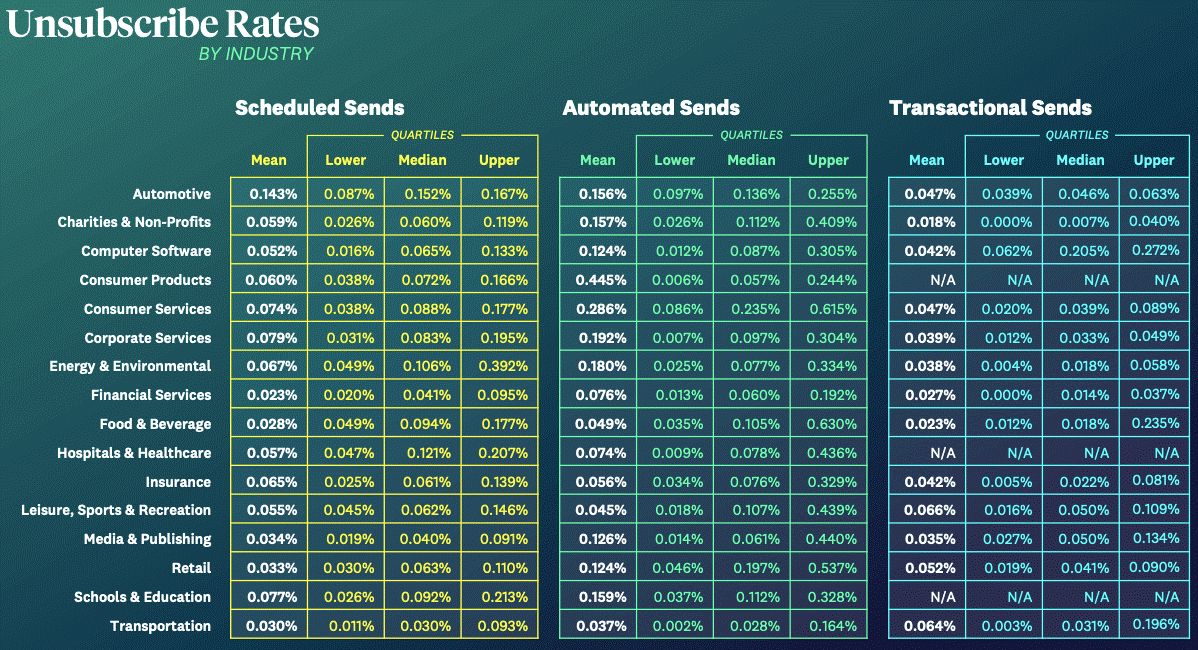
Source: (https://www.smartinsights.com/email-marketing/email-communications-strategy/statistics-sources-for-email-marketing)
In accordance with the aforementioned report, we have unsubscribed benchmarks as well:
-Automotive Segment shows a high unsubscribe rate for automated sends: Automotive industry is characterized by higher mean unsubscribe rate for automated emails at 0.156% thus making it the largest mean compared to other sectors of message delivery. This implies that people in this field tend to view their automated letters as being less appealing or engaging.
-Low unsubscribe rates in transportation sector for transactional sends: Within the transportation sector there exist some really low figures regarding unsubscribing, when it comes to sending transactional e-mails; an average of about 0.064%. This means that it feels like such emails are important or useful to those receiving them.
-The low unsubscribe rates in Computer Software Industry: The Low mean unsubscribe rates in the computer software industry during schedules sends is 0.052%. This indicates that the industry has been able to maintain relevance and value in all its email communications long.
-High Unsubscribe rates for Consumer Products in Automated Sends: The consumer products industry has a significantly higher mean unsubscribe rate for automated sends at 0.445%. This indicates that there is a mismatch between what these automatic emails say and what this group of subscribers would like to receive.
-Education Sector’s Varied Unsubscribe Rates: A 0.077% average unsubscribe rate from scheduled emails suggests the schools and education sector does not comply with subscriber expectations. However, it is not possible to find this figure regarding transactional deliveries implying either that there is no such information or such letters are rarely sent and monitored by those who work close to them.
The Content of Emails and the Personality in Them
Visual Email Preference
The above shows that 65% of the people receive emails with most pictures which imply that the way something looks can determine how much one will be interested. This means that emails with photographs may seem good for most people since they are easy to understand and inform quickly.
Personalized Emails are More Profitable
Research shows that email messages that are tailored to individuals earn 6 times more money and have six times more transactions than generic ones. Personalization may involve mentioning a person’s name or referencing their previous purchases and browsing activities when crafting an email message.
Targeting Efficacy
The statistic indicating that proper targeting can drive 3x the revenue per email as compared to non-targeted broadcasting highlights the importance of segmentation. Email marketers who segment their lists based on demographics, interests or behavior are able to create more relevant messages which in turn allow them to earn higher profits.
Marketing Automation Adoption
The reality that 75% of marketing professionals use at least one type of marketing automation tool shows the way this industry is evolving into an area where speed and accuracy matter most. It is through software that facilitates personalized messages because they allow you to send thousands of emails at once.
ROI for Segmentation
The realization that segmented mailing lists generate more than three times the income for each reader than non-segmented lists strengthens the point on segmentation. It also reflects on how targeted messages pay off better.
CTA Optimization
Finally, the number showing a Change text link to a button increases by 28% will serve as an example of why design and user experience matter. For instance, if one had an eye-catching call to action (CTA) with sleek lines it would go a long way in enhancing user involvement and possibility of clicking.
Conclusion
With email culture established, this letter demonstrates how marketers can track their marketing campaigns. You will also know how to coerce the detailed bulk mails that reach your specified target groups; hence recouping money lost due to low sales via emails you sent previously or may generate any increment on the same revenue source. Are you already working on some emails? If yes, it means these standards are guiding lights that shed more light towards getting better and more powerful results for your email marketing agenda.

